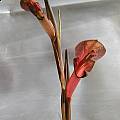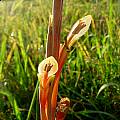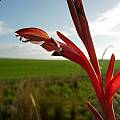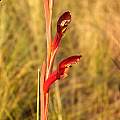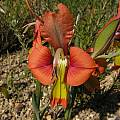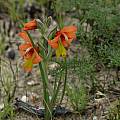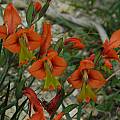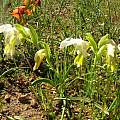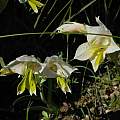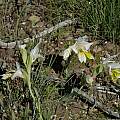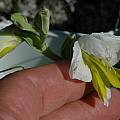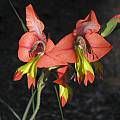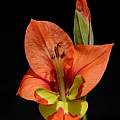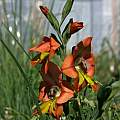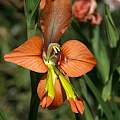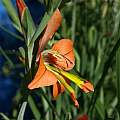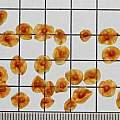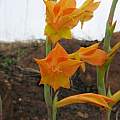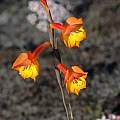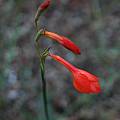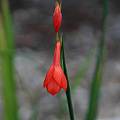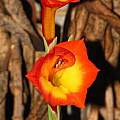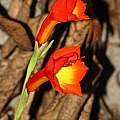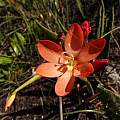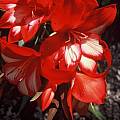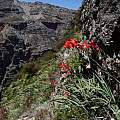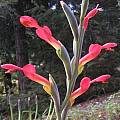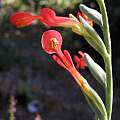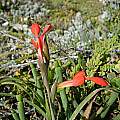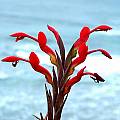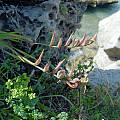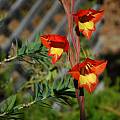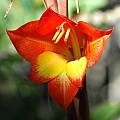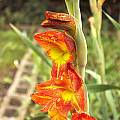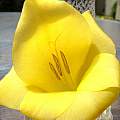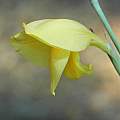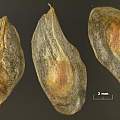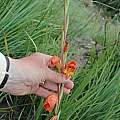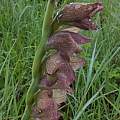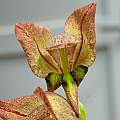Several species settle for these clear signal colors, often associated with bird pollination. This may result in very special flower shapes with long perianth tubes.
Though magenta is considered the basic red in printing color systems, we follow the common western color perception. Magenta colored Gladiolus can be found in the Purple Gladiolus index.
Page 2: G. engysiphon... Page 3: G. meridionalis... Page 4: G. pulcherrimus... Page 5: G. stefaniae...
Gladiolus abbreviatus Andrews (syn. Homoglossum abbreviatum) is an odd species with grossly unequal dark red to brown tepals. It is pollinated by sunbirds and occurs in the southwestern Cape where it is found in clay and shale banks in renosterveld. Although in the book above it is described as usually having 4 to 6 flowers my plants grown from seed only have a couple and ones seen in the wild also did not have very many flowers. The first photo was taken by Mary Sue Ittner of seed grown plants and the last three in habitat by Cameron McMaster near Napier in the Overberg.
Gladiolus alatus L. is a winter rainfall species found on flats, slopes, and plateaus, mainly in sand. The flowers are orange, marked yellow and have a light and pleasant scent. Photo 1 was taken near Paarl September 2003 by Bob Rutemoeller. The next two pictures were taken by Bob Rutemoeller and Mary Sue Ittner near Bainskloof September 2006.
Photos below are a white form of this species. The first photo was taken by Alan Horstmann. The next two photos from Mary Sue Ittner and Bob Rutemoeller were taken near Villiersdorp. The last photo by Bob Rutemoeller shows a white form for sale in a nursery in Caledon.
The photos below are of plants in cultivation. Photo 1 by Mary Sue Ittner shows flowers on a plant grown from seed blooming March 2005. Photo 3 from Bob Werra. Photos 3-6 were taken by Nhu Nguyen. Photo 5 show seeds on a 1 cm square grid.
Gladiolus aurantiacus Klatt is found in the summer rainfall area often growing in high grassland and is centered in KwaZulu-Natal extending into Mpumalanga and Swaziland. Growing from 45 to 75 cm high, it has stem leaves with short blades and foliage leaves with longer blades that are produced on separate shoots near the end of flowering. The unscented flowers are yellow, dotted or streaked with red or orange which gives them the appearance of being orange borne on a 10 to 16 flowered erect spike. Flowers have an elongate flower tube, slender in the lower half. The dorsal tepal is slightly ascending to horizontal and the lower tepals with yellow blotches in the lower half curve sharply downward. Flowers are adapted for pollination by sunbirds. Flowering is unusual as it occurs early, mostly in September and October, before the main rainy season has started. Photo from Rachel Saunders.
Gladiolus bonaspei Goldblatt & De Vos (as Gladiolus bonaespei) is a species that has had many different names with a new one expected shortly. Although Kew spells the species name Gladiolus bonaespei which is the spelling used when it was named, Goldblatt and Manning in Gladiolus in Southern Africa corrected the spelling to Gladiolus bonaspei. Other synonyms are Homoglossum merianellum (Thunb.) Baker, Homoglossum merianellum (Thunb.) Baker var. aureum G.J.Lewis, and Petamenes pilosus (Klatt) Goldblatt. It has also been known as Watsonia pilosa. According to John Manning the name is soon to change back to Gladiolus merianellus (L.) Thunb. The name is for [Cape] of Good Hope. This species grows on sandy flats and slopes in the Southwest Cape. It has 2 to 7 orange, rarely yellow flowers. Flowers held up very well during a wet period in February when they bloomed and over the course of the blooming period the color changed slightly from all orange to orange with yellow tones. The first photo is from Rod Saunders. The next three photos are from Mary Sue Ittner and the following two are by Dylan Hannon of the first flowering of his seed-grown plants 10 years after sowing.
Gladiolus brevitubus G.J.Lewis grows on rocky sandstone slopes in the Southwestern Cape and flowers in spring. Plants grow from 12 to 35 cm high. Flowers are unusual, resembling a Tritonia, orange with yellow markings at the base of the lower tepals. Leaves are linear with lightly thickened margins and midribs. The photo was taken December 2013 by Rachel Saunders on steep slopes in the mountains near Hermanus.
Gladiolus cardinalis Curtis grows on wet cliffs and waterfalls in the southwestern Cape area of South Africa where the corms are wedged into cracks in the rocks where they are protected. Corms and roots must be constantly wet. This species flowers in the driest time of the year in midsummer (mid December to mid January), and is pollinated by the mountain pride butterfly. It is often found growing together with Disa uniflora, an orchid pollinated by the same butterfly. Growing from 55 to 90 cm tall, it has bright red flowers with white spear-shaped marks. This very beautiful species was one of the parents of modern day hybrids. The first photo was taken by Rod Saunders. The second photo from Rachel Saunders was taken January 2013 where it grows in a waterfall that plunges down the side of the mountain off a cliff that is probably 500 m high.
Gladiolus cunonius (Linnaeus) Gaertner (syns. Anomalesia cunonia, Antholyza cunonia) has bright red flowers and blooms in the spring and grows in sandy soils near the coast. The first three photos were taken by Bob Rutemoeller and Mary Sue Ittner and the next three by Cameron McMaster in habitat near Agulhas and Arniston in the Overberg. The last picture shows the seed capsules hanging over the cliff near the ocean.
Gladiolus dalenii Van Geel is a widespread and common species found not only in Southern Africa, but also in other parts of tropical Africa. It has been known by a number of names over the years; there have been 27 synonyms for the tropical Africa and Madagascar forms and 14 more for the southern African forms. The main synonyms for the southern Africa collections have been Gladiolus natalensis and Gladiolus psittacinus. This species blooms at different times of the year depending on the location, but there are probably flowers every month of the year somewhere in its native habitats. Flowers are either red to orange with yellow markings on the lower half of the three lower tepals or yellow to greenish with red to brown streaks on the upper tepals. Although it favors moist habitats and is often found in grassland, it can also be found in dry habitats with only a short wet season. The ones I grew in Northern California lived for a number of years in the garden, dormant during our wet winters, appearing late spring and surviving through the dry summer and blooming in the fall. The flowering stalks were very tall with a number of flowers. Photos 1-2 of those plants were taken by Mary Sue Ittner. Photo 3 by Cameron McMaster shows plants in cultivation. Photos 4-5 by Mary Hunter and Mary Sue Ittner show the first bloom from seed of a yellow form of ssp. dalenii, once known as Gladiolus primulinus blooming in late summer in Northern California. The last photo by David Pilling shows seed.
The first photo below from Cameron McMaster shows flowering plants in habitat in the Eastern Cape. The second is another habitat shot taken near Balloch in the Eastern Cape, January 2010 by Bob Rutemoeller. Photo Nr. 3 from Rachel Saunders shows an unusual color form and was taken in northern KwaZulu-Natal in January 2015. The last photo shows the beautiful detail on likely the same color form, as the seeds were obtained from Silverhill, flowering the second year from seed for Martin Bohnet.
Page 2: G. engysiphon... Page 3: G. meridionalis... Page 4: G. pulcherrimus... Page 5: G. stefaniae...
